Intel NUC 11 Pro (NUC11TNKi5) Power Consumption and Noise
In terms of power consumption, we saw some fairly solid figures. Here are the basics:
- Idle: 11W
- 70% load: 40W
- 100% load: 49W
- Max observed: 64W
This is generally less than the 1L systems with “T” series 35W processors. At the same time, the savings are in the low single-digit Watt range and the maximum is perhaps slightly higher. For most of our readers, this would not push us to get a NUC over a 1L TinyMiniMicro PC. Just because this is a 10nm CPU does not mean we necessarily get less power consumption.
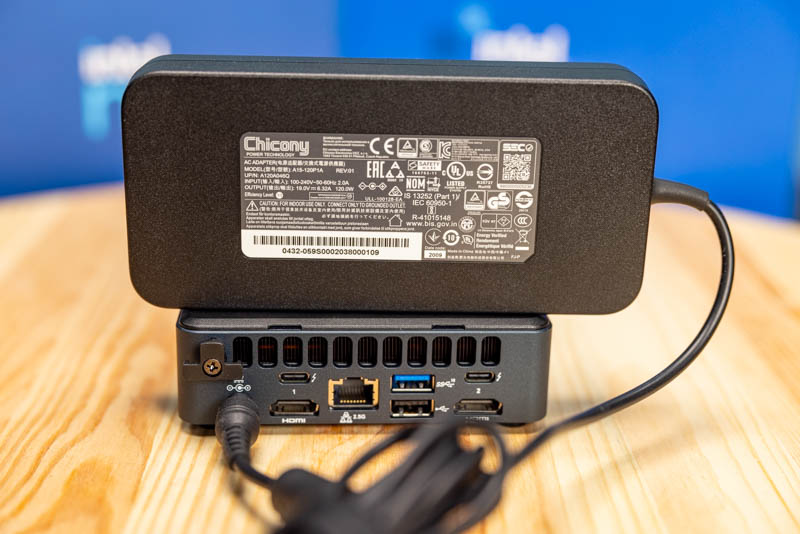
Something we wanted to note here is that this is far from a silent system. It is not terribly loud, but in the 40-70% duty range the fan is audible and louder than most of the newer TinyMiniMicro 35W nodes (8th Gen Core and newer.) The hypothesis is that the fan is ramping due to less area being dedicated to cooling.
Key Lessons Learned
Let us get to pricing for a moment. With this system, we have a unit that costs around $499, but the street price can be in the $480 range. For that, one gets the CPU, motherboard, chassis, and power supply. One still needs a SSD or two plus memory to get the system going. One also needs a Windows 10 license unless they are running Linux (Ubuntu and Red Hat are listed as supported.) Realistically, we see these hitting something equivalent to a Project TinyMiniMicro node in the $750-800 range.
That puts it firmly in the realm of the Lenovo ThinkCentre M75q Gen2 Tiny we reviewed.
There are certainly merits to both the Lenovo M75q Gen2 Tiny and the Intel NUC 11 Pro. The Lenovo unit benefits from much higher CPU performance (also with slightly more power consumption) but also AMD DASH management and a 1-year on-site warranty. The Lenovo unit is a higher-quality metal design that requires a single screw to open and service. Opening the chassis is optional since it is a pre-assembled system. To be fair, we also got accessories such as a keyboard and mouse with the Lenovo. Although it is larger, that size difference is offset partly by the NUC’s larger power supply.
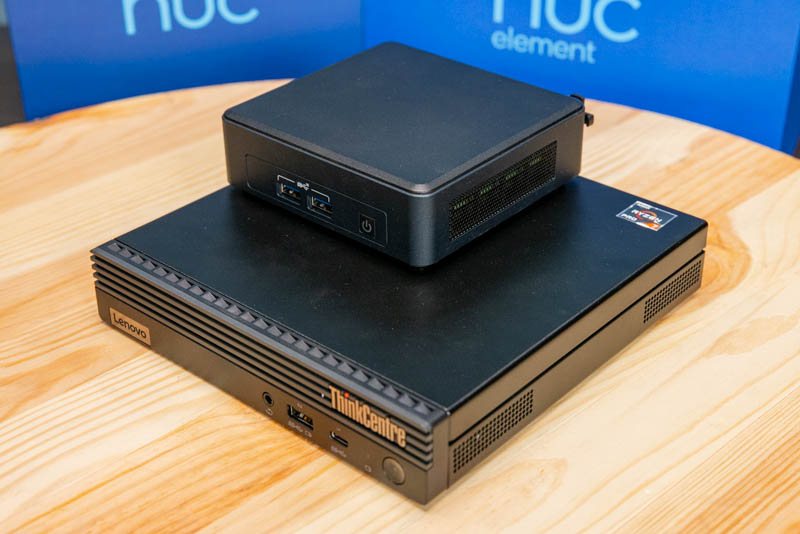
What the NUC has, and is important, is that it has much better I/O. USB, Thunderbolt, PCIe Gen5, and 2.5GbE are all upgrades. In the lab, we have the M75q Gen2 along with four Intel 10th Gen Core-based systems, and those all generally have similar connectivity with 1GbE and without Thunderbolt. Intel offers a three-year limited warranty, but it is not on-site. One also has to assemble the NUC (or pay a premium for a 3rd party to assemble) and the warranty from Intel is on the NUC, not on the system with the drive(s) and memory. One then needs to install the operating system, especially if it is Windows which is another step.
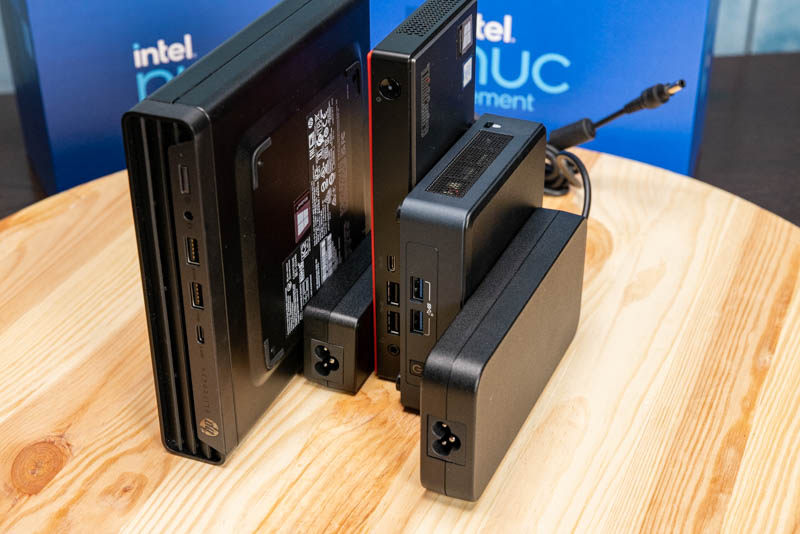
Looking beyond new nodes, one can spend a lot less for similarly fast Project TinyMiniMicro nodes. If a 2.5GbE network and Thunderbolt/ USB are not major features, then simply getting a TinyMiniMicro node from a generation or two earlier will offer a much better value.
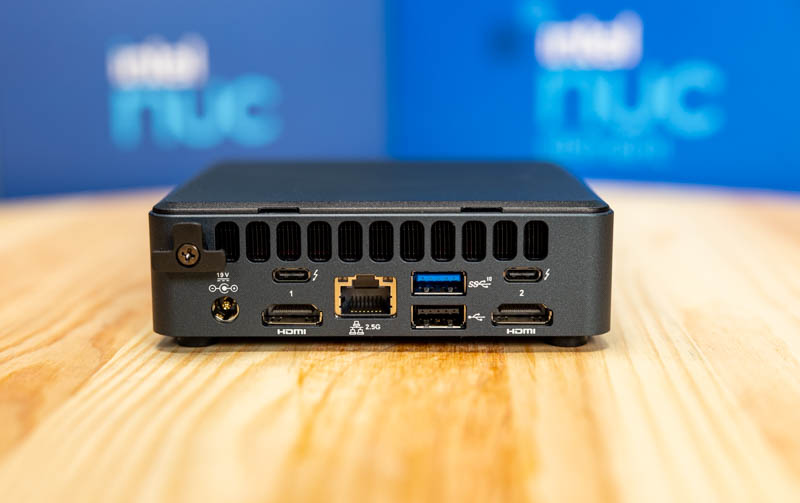
Our basic thought is that compared to Project TinyMiniMicro nodes thus far, it is not necessarily as fast, nor does one get the ease of a large OEM’s high-volume platform. The big differentiator is the I/O since the CPU is not as fast either. Intel has higher-end CPUs in NUCs, but ultimately there are TDP limitations one must contend with. That also increases cost.
Final Words
Overall, this is a very nice unit. There is something nice about having a small system that one can tuck away behind a monitor, TV, under a desk, in a kitchen, or wherever. If one thinks of the system as a compute-only node, then it is not going to be as good as the TinyMiniMicro nodes that are 1L in size. If one instead thinks of this as a hub to connect multiple devices, then it is a great solution.
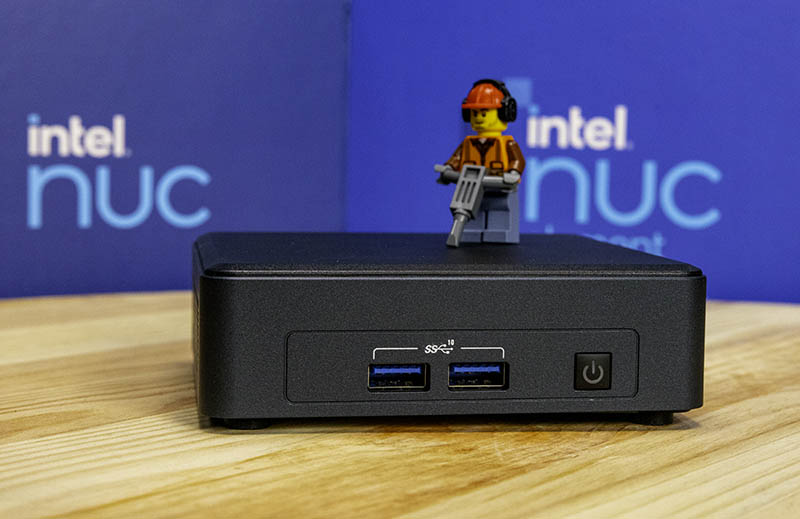
At the end of the day, the NUC 11 Pro has panache to it that one has to embrace. Clearly, a larger unit will be more practical. The NUC is not all about practicality, it is also about the “cool factor” of having a small system like this. Some will immediately gravitate to the platform while others will wish it had just one or two additional features that just are not possible in this form factor. We wanted to show off the unit so our readers can make informed decisions themselves.




It would be nice to include noise measurements for all these compact units using a calibrated decibels meter. The reason is that in many office, home and home-lab environments the noise footprint may be more important than the physical footprint.
Eric, I 100% agree. I had to do this one at my house and between the work they are doing outside landscaping/ cutting down trees this week, and the fact we have other stuff for all of the launches running means the noise floor outside of my office was too loud. The data center does not help with this since that requires ear protection.
Is there a version of this with ECC memory and enterprise management?
Also, that power brick is bigger than the 200w 19v unit that came with my MSI gaming laptop with an RTX GPU!!!
Sure that brick isn’t for the NUC elements? :o
The big thing that stands out to me is the front doesn’t have the shiny area that hides a CIR interface. Patric, can you confirm if this still has CIR for remote control interfaces like all the previous generations? I have been using NUC’s for HTPC’s and it would suck loosing that.
Would be great to hear the opinion on some of the more powerful vaults (https://protectli.com/vault-6-port/) for a more full featured SOHO firewall router, where more opnsense or untangled extras turned on. A common (seems to me) scenario these days of home network with separate personal, home office, appliances, and guest VLANs.
I have always found the NUC form factor to be interesting, but I have never found it to be practical.
I believe that there is a bounding limit between physical size, computing power, and heat dissipation that this NUC does not get right.
No, I’m not one of those “passively cooled PC types that believes in heatsinks in any insane size necessary”. There is another website that specializes in that stuff /facepalm/
I have a few small passively cooled PCs at home. They all have cases around the size of the Lenovo in the picture, maybe twice as thick/tall. They all work well, but, as expected, they will “thermal out” under heavier computing loads. That is what I have come to expect of the Intel NUC form factor; it cannot dissipate heat fast enough without resorting to active cooling measures that add noise. NUCs are fine, if you don’t push them to the performance levels supported by the higher end processors found in some NUCs.
And noise you ask? Look at the fans required to cool 1U servers and the speeds they must operate to do that job effective, lest an entire chassis panel be devoted to cooling fans. I refer you back to the recent STH article on the ASRock 1U server. That’s part of the dilemma of reducing size; it limits how much cooling capacity you can achieve without resorting to “mind blowing fan noise” (pun intended).
I think the Lenovo form factor in the picture is fine and I might be tempted to buy one if I needed one, but not the NUC form factor. Overheating due to poor passive cooling design (air space is required to make it work), or noisy operation due to aggressive active cooling (1U forced-air cooling concept), or thermally limited CPU operation because of issues with either of the former concepts.
Another issue that has always kept me from considering Intel NUC products has been their use of Realtek NICs rather than their own Intel NICs. Granted, Realtek NICs are decent and very cheep in large quantities, but, they break more than Intel NICs. I have “tossed out” multiple broken Realtek NICs, but I have NEVER HAD AN INTEL NIC FAIL. You would think Intel would be in a position to cut itself a good deal on their own NICs, even a low-end i210 basic Gig-E NIC. BUT NOOO! If I wanted the better NIC in my NUC I would have to fork out for a higher end NUC for a better NIC and risk the previously mentioned issues with heat and thermal limiting.
Honestly, Intel has proven quite capable of designing very good NICs, much like 3Com (remember them?) did with their family of NICs. Intel can be revolutionary in CPU design, at times, but sometimes they attempt things that are simply too risky in a security sense. How long have network security and firewalls and access controls been around? Since at least the IBM RACF program on mainframes?
Ok, another good STH review, but this product is not for me. It’s a niche product leveraging technical virtual signalling. It’s a POC product that has outlived it’s time in the marketplace.
I have an “H” series NUC (fits 2.5″ SFF drive) in front of me with Core i7-8650U quad core.
The fan is nothing short of annoying and I’m not doing much at all with it at the moment. Typing into this comment box and a work VM running in the background. CPU is @ 10% at 2.2GHz.
The number 1 complaint we’ve had since around the 7th/8th generation NUC with higher end higher TDP CPUs is fan noise. Plus, the top does get quite hot.
So, we’ve stopped selling anything above a Core i3 that are being used as Windows Remote Desktop terminals and that’s it.
Small Form Factor like the Tiny makes a lot more sense for higher TDP CPUs that are sensitive to air flow needs.
Sleepy – it’s an Intel nic. Stated on the first page of the review.
If AX201 is replaced with AX210, would the antenna configuration work well with the added Wi-Fi 6E (and BT 5.2) using 6GHz spectrum or would you need other antennas to be able to take advantage of 6GHz?
Patrick, you might miss the point that you don’t need the power brick if you connect the NUC to a monitor via USB-C connector. In that case this thing is really shining. Very small form factor and excellent IO.
M.2 2280 “NVMe only” looks like deal-breaker.
John – this SKU unfortunately seems to lack CIR but there’s other models available with CIR!
ECC! please pretty please!
110mm M.2 and PLP…. I can wish…
storage performance is absolutely what I’m interested in this for because the Xe QS acceleration for transcode jobs and TB4 is suggesting it to me for connecting to a MacBook to assist with video editing work.
EK! Precisely – you have it right there!
I’m figuring out how this could travel with a M1 MacBook and a monitor and I think it’s looking pretty good despite lacking in my wishes.
whats the performance like compared to the 8th gen whiskey lake nucs?
Never mind a canyon full of hungry tigers, what about a canyon full of horny Tiger Kings?
Not having vPRO is a deal breaker.
Version with vPRO is the NUC11TNKv5 (or v7)
There is brief mention of the iris Xe GPU upgrade. A feature that sadly never made it to desktop 11th Gen, yet wasn’t elaborated on any further.
I’d very much like to move forward with a media library project, but am really trying to go AV1, rather than dealing with H264/265.
Obviously the streaming/Plex infrastructure isn’t quite there yet, but within the next 2 yrs I’m expecting most streaming devices to support AV1 decode at least.
My current plan was to rip, and probably transcode with an i9-10900/T/K, depending on pricing, other factors.
But as AV1 H/W encode isn’t yet supported on anything other than Intel’s discrete GPUs, I don’t expect there to be any diff in perf between 10/11/12/13th gen. Leaving me to potentially pickup a cheap Intel Arc A380 or similar, for transcoding.
Can you elaborate/confirm any further on iGPU/QSV AV1 performance? Other than decode support, does 11th+ provide any tangible benefit here?
Also, with Intel depricating SGX support after 10th Gen, effectively killing UHD BD support, I would imagine using 11+ would be more limiting for ripping…
Love your more enterprise/enthusiast perspective content!